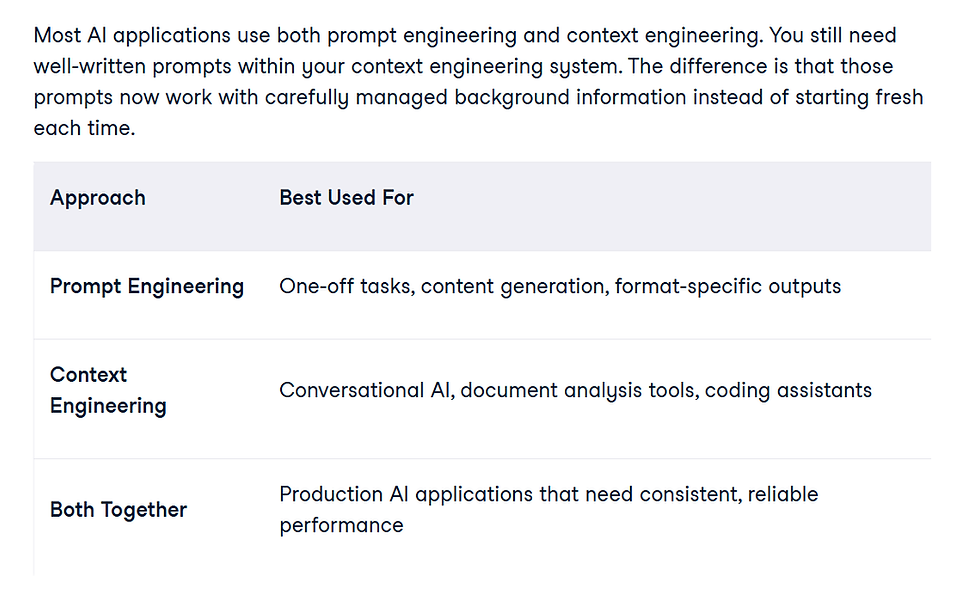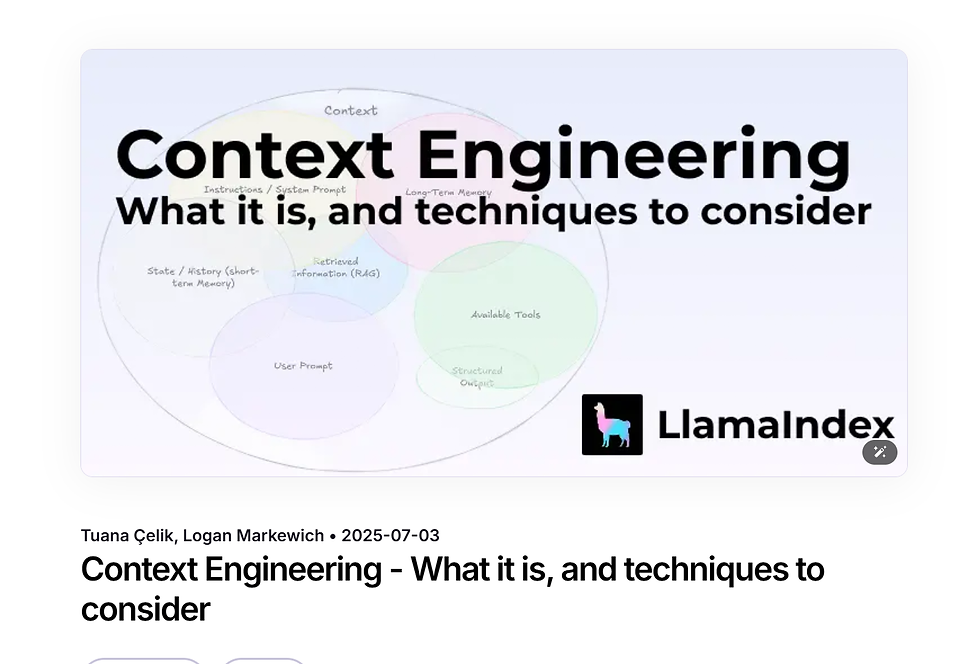Context Engineering: Elevating AI Strategy from Prompt Crafting and Context Management to Enterprise Competence
- Judy

- 2 hours ago
- 6 min read
In the era of generative AI, the true differentiator for enterprises lies not in adopting large language models (LLMs) as standalone tools, but in building an AI-native cognitive infrastructure that enables these models to understand, adapt, and evolve with the organization’s unique context. While prompt engineering focuses on optimizing human-AI communication, context engineering addresses a deeper challenge: how to embed an enterprise’s business logic, culture, and operational nuances into AI systems, transforming generic LLMs into "enterprise-specific intelligences." This article explores the essence of context engineering, its technical and organizational dimensions, and why it has become the cornerstone of sustainable AI strategy.
I. The Essence of Context Engineering: Beyond Data to Deep Understanding
Context engineering is the discipline of structuring and operationalizing the contextual knowledge that allows AI to function as a trusted collaborator within an organization. Unlike traditional data management, which focuses on storage and retrieval, context engineering creates a semantic layer that defines:
What matters to the enterprise (e.g., core values, strategic priorities);
How things work (e.g., workflows, decision hierarchies, industry-specific rules);
Who is involved (e.g., roles, permissions, cross-functional dynamics).
Key Components of Context
Explicit Context
Structured Data: Organizational charts, CRM records, ERP transactions, and compliance frameworks.
Unstructured Knowledge: Policy documents, meeting minutes, customer feedback, and expert interviews.
Example: A retail enterprise’s explicit context includes inventory turnover ratios, supplier contracts, and regional sales targets.
Tacit Context
Cultural Norms: Decision-making styles (e.g., consensus-driven vs. top-down), risk tolerance, and employee engagement patterns.
Industry Expertise: Unspoken rules in supply chain management (e.g., "prioritize vendor reliability over cost during peak seasons") or healthcare (e.g., "patient privacy supersedes operational efficiency").
Example: A tech startup’s tacit context may include a "fail-fast" culture that prioritizes innovation over process rigidity.
Dynamic Context
Real-time Signals: Market trends, regulatory updates, employee sentiment surveys, and IoT-generated operational data.
Example: A logistics company’s dynamic context includes real-time traffic data, weather forecasts, and sudden shifts in consumer demand.
Why Context Engineering Matters
Bridging the General-Particular Gap: LLMs like GPT-4 excel at general knowledge but struggle with enterprise-specific nuances. Context engineering teaches AI to recognize that "customer success" in a SaaS company means "reducing churn," while in retail, it may mean "increasing repeat purchases."
Enabling Actionable Insights: Generic AI might suggest "improve customer retention," but context-aware AI could recommend "launch a loyalty program for high-value customers in Region X, where churn rates have risen by 15% due to competitor promotions"—rooted in the enterprise’s unique data and priorities.
Mitigating Risks: By embedding compliance rules and ethical guardrails into context, organizations prevent AI from generating biased hiring recommendations or non-compliant financial reports.
II. The Technical Architecture of Context Engineering
1. Knowledge Graphs: Mapping the Enterprise’s Cognitive Landscape
A knowledge graph (KG) is the backbone of context engineering, serving as a structured representation of entities (e.g., employees, products, suppliers) and their relationships (e.g., "Product A is manufactured by Supplier B and sold to Customer C").
Entity-Relationship Modeling:
Entities: Employees, departments, customers, contracts, and even intangible assets like "corporate culture" or "brand reputation."
Relationships: "Reporting structure," "supply chain dependencies," "customer journey touchpoints," and "cross-functional collaboration patterns."
Case Study: A global pharmaceutical company built a KG integrating clinical trial data, regulatory guidelines, and sales territories. This enabled AI to generate country-specific drug launch plans compliant with local regulations, reducing regulatory review cycles by 30%.
Semantic Enrichment:
Assigning labels, taxonomies, and ontologies to ensure consistency. For example, defining "Q3 revenue" as "the sum of sales from July to September, excluding returns and discounts."
Resolving ambiguities: Distinguishing "board of directors" (governance body) from "advisory board" (consultative role).
2. Dynamic Context Layers: Feeding Real-Time Intelligence
Context is not static. Enterprise AI must adapt to:
Internal Dynamics: Shifts in organizational strategy (e.g., pivoting to sustainability), mergers, or employee turnover.
External Dynamics: Market disruptions (e.g., new competitors), policy changes (e.g., GDPR updates), or global events (e.g., supply chain crises).
Technical Solutions for Dynamic Context
Real-Time Data Pipelines: Integrating IoT sensors, social listening tools, and ERP updates into the KG.
Example: A manufacturing plant uses real-time machine sensor data to update its AI’s context, enabling predictive maintenance recommendations that reduce downtime by 25%.
Event-Driven Triggers: Automatically updating context when predefined events occur (e.g., "trigger a risk assessment if supplier X’s delivery delays exceed 72 hours").
Federated Learning: Maintaining context privacy while collaborating with external partners. For instance, a healthcare network uses federated learning to share anonymized patient data across hospitals without compromising HIPAA compliance.
3. Contextual Decision Models: Embedding Business Rules
Effective context engineering translates abstract knowledge into actionable rules for AI:
Policy Engines: Embedding compliance rules (e.g., "all financial reports must include a carbon footprint analysis") into AI workflows.
Priority Hierarchies: Defining decision criteria (e.g., "safety regulations override cost-saving objectives in production scheduling").
Role-Based Context Access: Ensuring AI provides tailored insights based on user roles. For example, a CFO sees AI-generated financial forecasts with sensitivity analysis, while a department manager receives simplified trend reports.
III. Organizational Dimensions of Context Engineering
1. Context as a Strategic Asset: Aligning with Business Goals
Context engineering is not a technical exercise but a strategic imperative that requires alignment with the organization’s mission:
Goal-Driven Context Design:
If the goal is "accelerate innovation," context might prioritize R&D data, patent libraries, and cross-departmental collaboration patterns.
If the goal is "enhance customer experience," context might focus on customer journey maps, sentiment analysis, and historical service records.
Leadership Buy-In: Executives must recognize context as a core asset, comparable to intellectual property or brand equity.
2. The Role of Context Stewards: Building Cross-Functional Competence
Effective context engineering requires a new breed of professionals: context stewards, who bridge technical expertise with organizational knowledge.
Responsibilities of Context Stewards:
Knowledge Curation: Identifying critical context sources (e.g., interviewing subject matter experts to capture tacit knowledge).
Context Governance: Establishing standards for data quality, access controls, and ethical use.
Change Management: Ensuring employees understand how context-aware AI augments their roles, not replaces them.
Cross-Functional Collaboration: Context stewards work with IT (to build infrastructure), HR (to align with workforce skills), and legal (to ensure compliance).
3. Overcoming Challenges in Context Engineering
a. Data Silos and Legacy Systems
Solution: Adopt a "context mesh" architecture that connects disparate systems (ERP, CRM, legacy databases) using APIs and middleware.
Example: A retail conglomerate integrated its e-commerce platform, in-store POS systems, and supplier portals into a single context mesh, enabling AI to generate unified inventory management strategies across channels.
b. Tacit Knowledge Capture
Solution: Use techniques like design thinking workshops, scenario planning, and expert shadowing to externalize tacit knowledge.
Example: A consulting firm recorded "war stories" from senior partners, converting their problem-solving heuristics into context rules for AI-driven project scoping.
c. Resistance to Change
Solution: Pilot small-scale context-aware AI applications (e.g., automating routine HR queries with context-specific responses) to build trust and demonstrate value.
IV. Context Engineering in Practice: Case Studies
1. Healthcare: Personalized Treatment Plans with Contextual AI
A leading hospital system implemented context engineering to improve treatment recommendations:
Context Components:
Patient medical history, genetic data, and lifestyle factors (explicit context).
Hospital policies on treatment protocols, insurance reimbursements, and ethical guidelines (tacit context).
Real-time data from wearables and lab results (dynamic context).
Outcomes: AI-generated treatment plans aligned with both medical guidelines and patient preferences, reducing treatment approval time by 40% and improving patient satisfaction by 28%.
2. Manufacturing: Predictive Maintenance with Operational Context
A global automotive manufacturer used context engineering to optimize factory operations:
Context Components:
Machine specifications, maintenance logs, and production schedules (explicit context).
Technician expertise in diagnosing rare equipment failures (tacit context).
Real-time sensor data on machine vibration, temperature, and energy usage (dynamic context).
Outcomes: AI predicted equipment failures with 92% accuracy, reducing unplanned downtime by 50% and cutting maintenance costs by 18%.
3. Financial Services: Ethical AI in Loan Underwriting
A regional bank embedded contextual ethics into its loan approval process:
Context Components:
Regulatory requirements (e.g., ECOA anti-discrimination rules) and internal risk appetite (explicit context).
Community demographics and historical lending patterns (tacit context).
Real-time economic indicators (e.g., unemployment rates, housing market trends) (dynamic context).
Outcomes: AI reduced bias in loan decisions, achieving a 95% compliance rate with fair lending laws, while increasing approval rates for small businesses by 22%.
V. The Future of Context Engineering: From Competence to Competitive Advantage
As AI matures, context engineering will evolve from a niche practice to a core competency that differentiates organizations:
Autonomous Context Evolution: AI systems will proactively update their context based on organizational feedback, similar to how humans learn from experience.
Cross-Enterprise Context Networks: Industries will develop shared context frameworks (e.g., supply chain standards, healthcare interoperability protocols), enabling seamless AI collaboration across ecosystems.
Ethics as Contextual Defaults: Ethical considerations (e.g., fairness, transparency) will be hardwired into context architectures, not bolted on as afterthoughts.


コメント